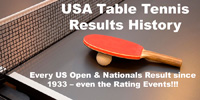What does your opponent do that most threatens you? it's important to find this out as early in a match as possible - or, ideally, before the match begins. That's why it's important to scout out opponents, either by watching them live or on video, or asking others about them.
Once you know what their strengths are, it's very simple: How can you nullify it? Because if you can't, you've already lost.
To use a simple example, suppose a player is really good at serving backspin and then looping any long push. He's unstoppable!!! Unless . . . you don't give him that long push that he likes to loop. And at most levels, most players often just push serves back, over and over, even if the opponent is effective at attacking them.
Instead, figure out early on how to stop his strength. In this case, you have a number of options - and it's always mind-boggling how so many players either don't think of these things, or - more often - don't think of them at the table, and only after the match figure it out. So, how would you stop this? If the serve is even slightly long, then loop it. (If you can't, learn to.) If it's short, then you have all sorts of possibilities. Flip. Push short. Push long but very quick off the bounce and fast and at a wide angle. Push long but super heavy or with varying spin at wide angles. Perhaps discuss it with other players or coaches, and they may have suggestions. Find what works!
If you can't do what it takes to stop the opponent's strength, then it's up to you develop what's needed to do so . . . for next time. Go to it!





